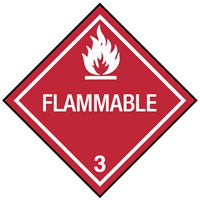
 Print
Print
Chemical Datasheet
ETHYL BUTYL KETONE |

|
Chemical Identifiers
| CAS Number |
UN/NA Number |
DOT Hazard Label |
USCG CHRIS Code |
- 106-35-4

|
|
|
|
| NIOSH Pocket Guide |
International Chem Safety Card |
|
Ethyl butyl ketone
|
|
NFPA 704
General Description
Colorless odorless liquid with a mild fruity odor. Flash point 140°F.
Hazards
Reactivity Alerts
Air & Water Reactions
Flammable.
Fire Hazard
Special Hazards of Combustion Products: Irritating vapors and toxic gases, such as carbon dioxide and carbon monoxide, may be formed when involved in fire. (USCG, 1999)
Health Hazard
Short term exposure can cause irritation of eyes, nose, throat and lungs. High concentrations may cause headache, dizziness or unconsciousness. (USCG, 1999)
Reactivity Profile
ETHYL BUTYL KETONE is reactive with many acids and bases liberating heat and flammable gases (e.g., H2). The amount of heat may be sufficient to start a fire in the unreacted portion. Reacts with reducing agents such as hydrides, alkali metals, and nitrides to produce flammable gas (H2) and heat. Incompatible with isocyanates, aldehydes, cyanides, peroxides, and anhydrides. May react violently with aldehydes, HNO3, HNO3 + H2O2, and HClO4. Irritating vapors and toxic gases may be formed when involved in fire (USCG, 1999).
Belongs to the Following Reactive Group(s)
Potentially Incompatible Absorbents
No information available.
Response Recommendations
Isolation and Evacuation
Excerpt from ERG Guide 127 [Flammable Liquids (Water-Miscible)]:
IMMEDIATE PRECAUTIONARY MEASURE: Isolate spill or leak area for at least 50 meters (150 feet) in all directions.
LARGE SPILL: Consider initial downwind evacuation for at least 300 meters (1000 feet).
FIRE: If tank, rail tank car or highway tank is involved in a fire, ISOLATE for 800 meters (1/2 mile) in all directions; also, consider initial evacuation for 800 meters (1/2 mile) in all directions. (ERG, 2024)
Firefighting
Fire Extinguishing Agents Not to Be Used: Water.
Fire Extinguishing Agents: Dry chemical, alcohol foam, or carbon dioxide. (USCG, 1999)
Non-Fire Response
Excerpt from ERG Guide 127 [Flammable Liquids (Water-Miscible)]:
ELIMINATE all ignition sources (no smoking, flares, sparks or flames) from immediate area. All equipment used when handling the product must be grounded. Do not touch or walk through spilled material. Stop leak if you can do it without risk. Prevent entry into waterways, sewers, basements or confined areas. A vapor-suppressing foam may be used to reduce vapors. Absorb or cover with dry earth, sand or other non-combustible material and transfer to containers. Use clean, non-sparking tools to collect absorbed material.
LARGE SPILL: Dike far ahead of liquid spill for later disposal. Water spray may reduce vapor, but may not prevent ignition in closed spaces. (ERG, 2024)
Protective Clothing
Excerpt from NIOSH Pocket Guide for Ethyl butyl ketone:
Skin: PREVENT SKIN CONTACT - Wear appropriate personal protective clothing to prevent skin contact.
Eyes: PREVENT EYE CONTACT - Wear appropriate eye protection to prevent eye contact.
Wash skin: WHEN CONTAMINATED - The worker should immediately wash the skin when it becomes contaminated.
Remove: WHEN WET OR CONTAMINATED - Work clothing that becomes wet or significantly contaminated should be removed and replaced.
Change: No recommendation is made specifying the need for the worker to change clothing after the workshift. (NIOSH, 2024)
DuPont Tychem® Suit Fabrics
No information available.
First Aid
Excerpt from NIOSH Pocket Guide for Ethyl butyl ketone:
Eye: IRRIGATE IMMEDIATELY - If this chemical contacts the eyes, immediately wash (irrigate) the eyes with large amounts of water, occasionally lifting the lower and upper lids. Get medical attention immediately.
Skin: WATER FLUSH - If this chemical contacts the skin, flush the contaminated skin with water. Where there is evidence of skin irritation, get medical attention.
Breathing: RESPIRATORY SUPPORT - If a person breathes large amounts of this chemical, move the exposed person to fresh air at once. If breathing has stopped, perform artificial respiration. Keep the affected person warm and at rest. Get medical attention as soon as possible.
Swallow: MEDICAL ATTENTION IMMEDIATELY - If this chemical has been swallowed, get medical attention immediately. (NIOSH, 2024)
Physical Properties
Flash Point:
115°F
(USCG, 1999)
Lower Explosive Limit (LEL):
1.4 %
(USCG, 1999)
Upper Explosive Limit (UEL):
8.8 %
(USCG, 1999)
Autoignition Temperature: data unavailable
Melting Point:
-38°F
(USCG, 1999)
Vapor Pressure:
4 mmHg
(NIOSH, 2024)
Vapor Density (Relative to Air): data unavailable
Specific Gravity:
0.818
(USCG, 1999)
- Less dense than water; will float
Boiling Point:
297°F
at 760 mmHg
(USCG, 1999)
Molecular Weight:
114.19
(USCG, 1999)
Water Solubility:
1 %
(NIOSH, 2024)
Ionization Energy/Potential:
9.02 eV
(NIOSH, 2024)
IDLH:
1000 ppm
(NIOSH, 2024)
AEGLs (Acute Exposure Guideline Levels)
No AEGL information available.
ERPGs (Emergency Response Planning Guidelines)
No ERPG information available.
PACs (Protective Action Criteria)
| Chemical |
PAC-1 |
PAC-2 |
PAC-3 |
|
| Ethyl butyl ketone; (3-Heptanone) (106-35-4)
|
75 ppm |
500 ppm |
3000 ppm  |
LEL = 14000 ppm |
(DOE, 2024)
Regulatory Information
EPA Consolidated List of Lists
No regulatory information available.
CISA Chemical Facility Anti-Terrorism Standards (CFATS)
No regulatory information available.
OSHA Process Safety Management (PSM) Standard List
No regulatory information available.
Alternate Chemical Names
- BUTYL ETHYL KETONE
- ETHYL BUTYL KETONE
- 3-HEPTANONE


 Print
Print
